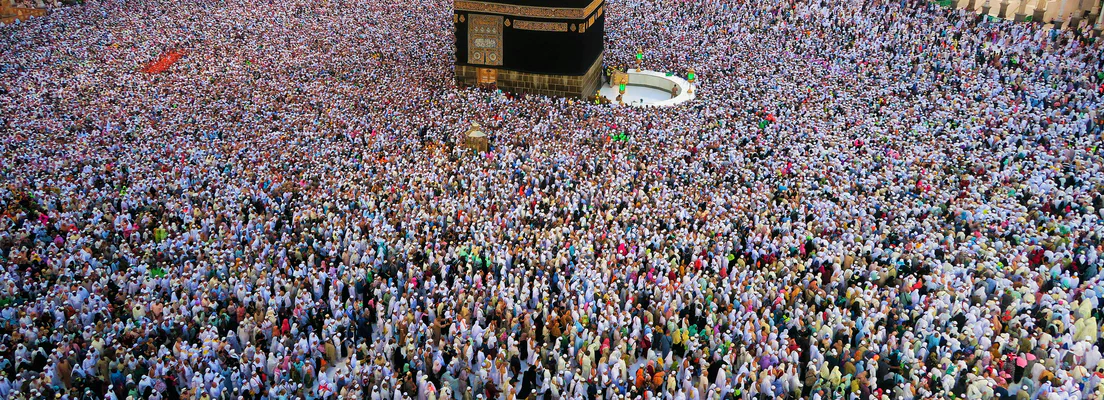It is a religious duty that every Muslim must undertake at least once in their lifetime, provided they have the physical and financial ability to do so. The pilgrimage occurs during the Islamic month of Dhu al-Hijjah and involves a series of rituals, including:
- Tawaf: Circumambulating the Kaaba seven times.
- Sa’i: Walking between the hills of Safa and Marwah.
- Standing at Arafat: A day of prayer and reflection on the 9th day of Dhu al-Hijjah.
- Ramy al-Jamarat: Throwing stones at three pillars, symbolizing the rejection of evil.
Hajj promotes unity among Muslims and serves as a spiritual journey of devotion, reflection, and community.
Pre-Islamic Era
Origins of the Ritual
Before the advent of Islam, the Arabian Peninsula was home to various tribes practicing polytheism. The Kaaba in Mecca was a central religious site, revered by multiple tribes. Key features of pre-Islamic rituals included:
- Polytheistic Worship: The Kaaba housed numerous idols representing different deities. Tribes would perform rituals to honor these gods, seeking favor and protection.
- Pilgrimage Practices: Pilgrimages to the Kaaba were common. Tribes would participate in rituals such as circling the Kaaba, known as Tawaf, although the specific meanings and practices varied among groups.
- Cultural Significance: The site served as a trade and cultural hub, fostering interactions between various tribes, which influenced their religious practices.
Similar Practices in Other Religions
Other ancient religions exhibited similar pilgrimage practices, including:
- Hinduism: Pilgrimages to sacred sites, such as the Ganges River, where rituals and bathing are performed for purification.
- Judaism: Pilgrimages to the Temple in Jerusalem during festivals like Passover, emphasizing communal worship and sacrifice.
- Christianity: Early Christians practiced pilgrimages to places associated with Jesus and saints, seeking spiritual experiences.
The Islamic Era (Post-Muhammad)
Transformation of Rituals
When Muhammad became a prophet in the 7th century, he redefined the existing pilgrimage rituals, emphasizing monotheism and the worship of Allah. Key changes included:
- Monotheism: The focus shifted from polytheistic practices to the worship of one God. Idols were removed from the Kaaba, which became a symbol of Islamic faith.
- Standardization of Practices: Rituals were codified, providing a clear framework for the Hajj. The rituals were now imbued with Islamic teachings, emphasizing humility, equality, and submission to Allah.
- Inclusivity: Hajj became an obligation for all Muslims, regardless of social status or ethnicity, promoting unity within the Muslim community.
Key Differences in Rituals
Nature of Worship:
- Pre-Islamic: Worship involved multiple deities and idols, with rituals often focused on seeking favors or blessings.
- Islamic: Worship is directed solely to Allah, emphasizing submission and devotion.
Purpose:
- Pre-Islamic: Rituals served to appease various gods and secure tribal favor.
- Islamic: Hajj is a demonstration of faith, obedience, and unity among Muslims, with a focus on spiritual purification.
Ritual Structure:
- Pre-Islamic: Rituals varied widely among tribes, with no standardized practices.
- Islamic: Hajj rituals are specific and obligatory, including Tawaf, Sa’i, Arafat, and Ramy al-Jamarat, all of which are performed in a defined sequence.
Contemporary Hajj Practices
In modern times, Hajj continues to be a significant spiritual journey for Muslims worldwide. Key features include:
- Global Participation: Millions from diverse backgrounds gather in Mecca, reinforcing the sense of global Muslim unity.
- Enhanced Logistics: Modern travel and accommodations have made Hajj more accessible, though it also raises concerns about overcrowding and infrastructure.
- Technological Integration: Use of technology for navigation, communication, and health services has improved the pilgrimage experience.
Conclusion
The evolution of the Hajj ritual reflects a profound transformation from pre-Islamic polytheistic practices to a unified expression of Islamic faith. While the essence of pilgrimage remains—a journey of spiritual significance—the meanings, structures, and community aspects have evolved significantly since the time of the Prophet Muhammad, continuing to resonate with millions today.



